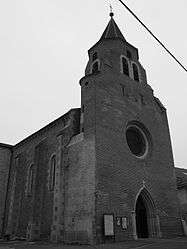Sainte-Livrade-sur-Lot
| Sainte-Livrade-sur-Lot | ||
|---|---|---|
|
The church in Sainte-Livrade | ||
| ||
 Sainte-Livrade-sur-Lot | ||
|
Location within Nouvelle-Aquitaine region  Sainte-Livrade-sur-Lot | ||
| Coordinates: 44°23′56″N 0°35′25″E / 44.3989°N 0.5903°ECoordinates: 44°23′56″N 0°35′25″E / 44.3989°N 0.5903°E | ||
| Country | France | |
| Region | Nouvelle-Aquitaine | |
| Department | Lot-et-Garonne | |
| Arrondissement | Villeneuve-sur-Lot | |
| Canton | Sainte-Livrade-sur-Lot | |
| Intercommunality | Villeneuvois | |
| Government | ||
| • Mayor (2008–2014) | Claire Pasut | |
| Area1 | 30.94 km2 (11.95 sq mi) | |
| Population (2011)2 | 6,182 | |
| • Density | 200/km2 (520/sq mi) | |
| Time zone | CET (UTC+1) | |
| • Summer (DST) | CEST (UTC+2) | |
| INSEE/Postal code | 47252 / 47110 | |
| Elevation |
37–194 m (121–636 ft) (avg. 50 m or 160 ft) | |
|
1 French Land Register data, which excludes lakes, ponds, glaciers > 1 km² (0.386 sq mi or 247 acres) and river estuaries. 2 Population without double counting: residents of multiple communes (e.g., students and military personnel) only counted once. | ||
Sainte-Livrade-sur-Lot is a commune in the Lot-et-Garonne department in south-western France.
Geography
Sainte-Livrade-sur-Lot is located along the banks of Lot River.
History
Human inhabitation has been present around the area since the early Iron Age. The commune of Sainte-Livrade-sur-Lot itself was founded in 1289 as Sainte-Livrade d'Olt, Olt being the Occitan and former name of the Lot River. The current name was adopted in December 1919.
Despite its small size, Sainte-Livrade-sur-Lot is a multicultural town that has been host to numerous immigrant communities since the 20th century. The first prominent immigrant community to the town were Italians who escaped the fascist regime of Benito Mussolini during the 1920s and 1930s. They were soon followed by Spanish immigrants, also escaping fascism in their homeland under Francisco Franco.
Following the First Indochina War in 1954, in which Vietnam won its independence from France, Vietnamese troops who fought alongside the French were brought to metropolitan France as a recognition for their loyalty to the country and for fear that they would be persecuted by the new independent government. The troops, along with their families, were housed at camps designated as Centre d'accueil des Français d'Indochine, of which Sainte-Livrade-sur-Lot hosted the largest of three.
Later immigrant communities to the town included Pied-Noirs from the newly independent former French colony of Algeria following the Algerian War in 1962. Immigrants from the Maghreb, especially Algeria, also began arriving in the 1970s and 1980s.
Demographics
In 2011, the population of the commune was 6,182.
Refugee camp
After France's defeat at the Battle of Dien Bien Phu and Vietnam's independence from France in 1954, roughly five thousand Vietnamese troops who fought for France, as well as their families and Vietnamese married to French colonists, were repatriated to the country. Their arrival led to the creation of refugee camps designated as Camps d'accueil des rapatriés d'Indochine (Center for the Reception of the French of Indochina), of which Sainte-Livrade-sur-Lot hosted the largest, containing nearly 1,500 people at its height. The camp was converted into barracks from a World War II munitions factory, in which residents lived in rudimentary conditions with a government sponsored hospital and school.[1]
The population of the camp declined as children of the refugees moved away from the area after they grew up, due to limited education and employment opportunities. Today, residents largely consist of surviving refugees and some families descended from the migrants. As the war in Indochina was unpopular, the French government did not do much to improve the lives of the community's people until recently, when plans were underway to convert the barrack-like homes of the camp to social housing. Nevertheless, Sainte-Livrade-sur-Lot hosts grocery stores and a Buddhist temple that serve the Vietnamese community.[1]
See also
References
| Wikimedia Commons has media related to Sainte-Livrade-sur-Lot. |

.svg.png)